




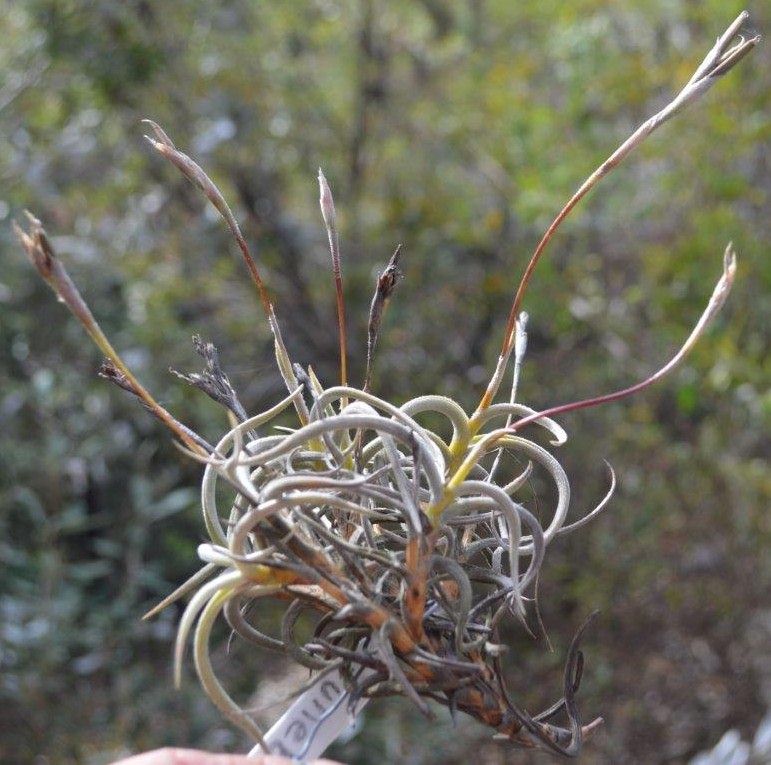
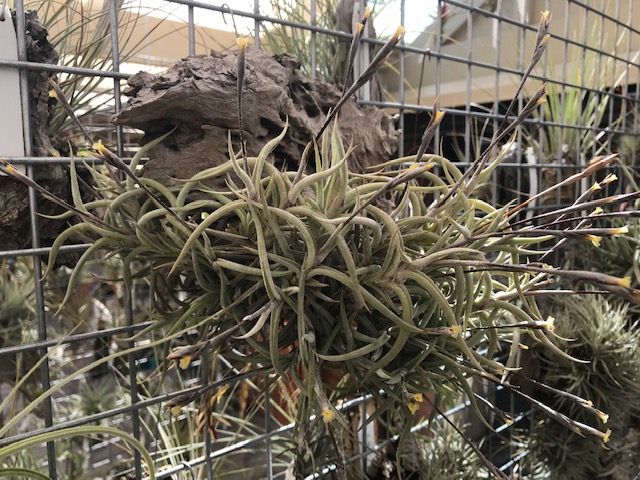
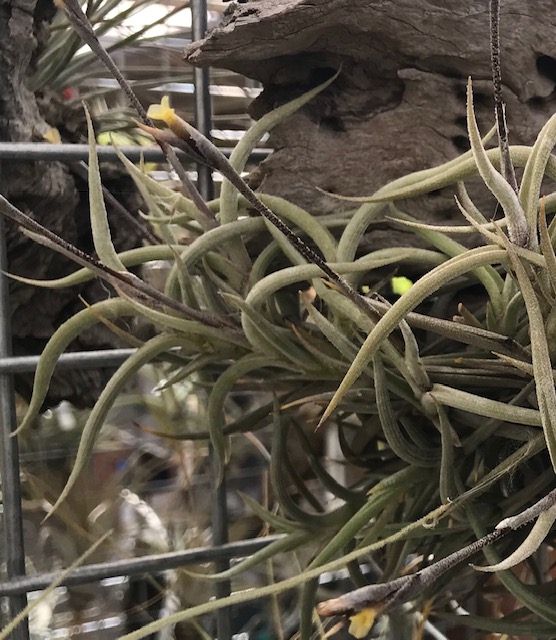
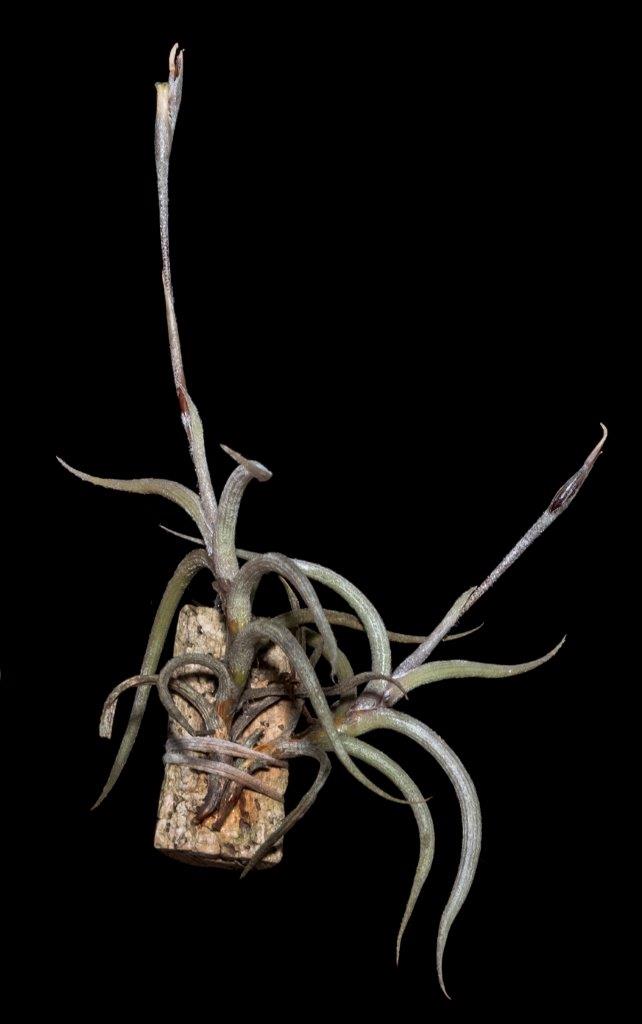
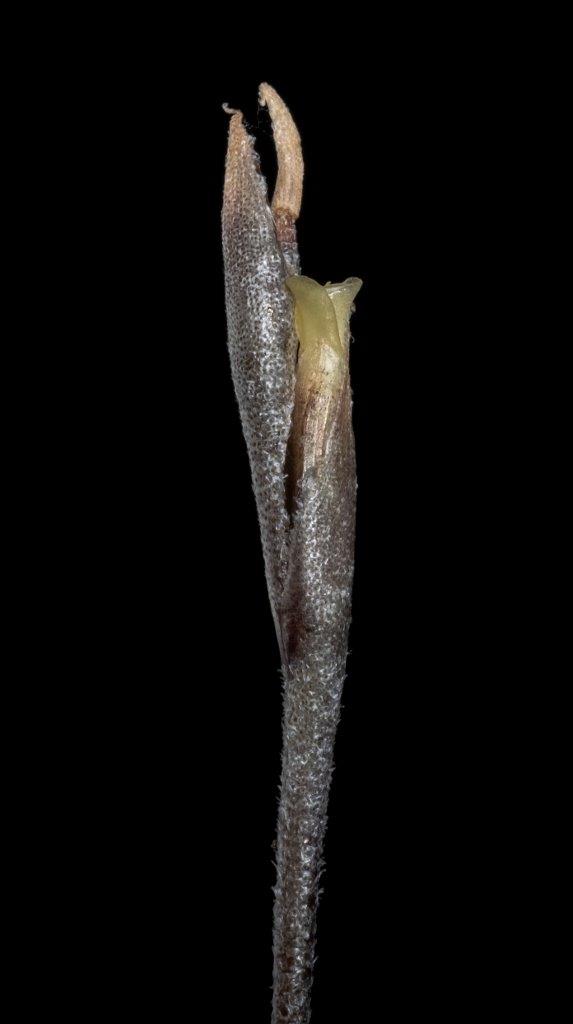
A TALE OF TWO MICE
OR T. myosura versus T. caliginosa by Derek Butcher, S.A. in Bromeletter 32(5): 8-9, 1994
This tale starts early in 1993 when an article appeared in the BSI Journal 1993 page 24, and which was a reprint of a previous article in 1975 by George Kalmbacher entitled "A Tale of a Mouse-Tail - with details". In between these 2 dates another plant with leaves like a mouse-tail had been named and I wrote an article for the BSI Journal pointing out the problem but for various reasons it was not published.
Let us go back to the late 1980's when I acquired copies of Rauh's Bromelienstudien and I had to quickly learn botanical German to help me understand these works. I translated, amongst many others, the description of a plant called Tillandsia crocata var. tristis. We all know that T. crocata is a pretty little plant with a large yellow flower and an exquisite scent. Here we had a variety with a small flower that was dirty yellowish brown. Needless to say I wanted to acquire one!
The next thing I found out was that Dr. Walter Till from Vienna had named a Tillandsia caliginosa and had split up what Smith & Downs had treated as T. myosura. The T. crocata var. tristis became a synonym of T. caliginosa. So the field was reduced to T. caliginosa and T. myosura.
It is interesting to note that in 1935, Lyman Smith indicated his worries about 2 of the collections within his concept of T. myosura and it took 50 years before anything was done about it.
I still didn't know what the real difference was and I went to the World Conference in Tampa in 1992 with high hopes of a solution. Instead of being rare, T. caliginosa was on sale everywhere but no T. myosura. In addition, this T. caliginosa looked like what I had been growing as T. myosura. When I asked the obvious question I was told it was easy to tell them apart but no one could tell me how!
So I went to the trouble of importinq this "new" species with the usual traumas and costs of quarantine. The plants survived and when placed side by side with the 'Aussie' T. myosura I could find no difference.
Dr. Walter Till is the current World authority on the sub genus of Tillandsia called Diaphoranthema. This sub genus includes T. usneoides, but generally speaking if the plant is small & has very small flowers with exciting colours like green, dirty yellow, brown, dark violet to black you are talking about Diaphoranthema. I felt I just had to contact Dr. Till in Vienna and as luck would have it he writes and speaks English. I sent him a few bits of the Aussie "T. myosura" and guess what?! It is T. caliginosa.
What is the difference between the two? Well, Dr. Till says this is what I have to look for....
T. myosura. Petals are always pure yellow in different hues, flower fragrance is not very strong. The leaves are not strictly distichous, very rigid and their sheaths, glabrous (naked) to lepidote. The inflorescence axis is often somewhat flexuous. Its habitat is in the arid areas near Cordoba, Argentina.
T. caliginosa. Petals are usually dark brown (hence the name), or if brownish yellow then spotted, flower fragrance is rather strong, the leaves are nearly exactly distichous, rather soft, and their sheaths strikingly glabrous. The inflorescence axis is usually nearly straight with rather long internodes. It is widespread in northern most Argentina and Bolivia.
By the way, if you cannot understand some of these terms I suggest you acquire a copy of "The Amateur's Guide to the Greyish Leaved Tillandsioideae".
The plant I call the 'Aussie' T. myosura came to Adelaide via Queensland about 1980 and offsets so prolifically that it has became the most common Tillandsia in Adelaide. For the first few years we kept finding seed pods but had never seen it flower. Maureen Hick was the first to claim a sighting and she pronounced its colour was dirty yellow. This spurred others to be on the look out but we were finding brown to be the colour. Eventually it 'dawned' on us that Maureen got up earlier than the rest of us and that us late risers were seeing the flower just on closing time! Whatever, you have to be quick and observant.
When your T. myosura flowers would you please check the colour of the petals and the rest of the description given previously. Remember, that in the wild T. caliginosa is much more widespread than T. myosura. You may have the rare one, but then .......!
Finally, you must have been wondering whether this is a tale or a tail. Well, in ancient Greek "myos" means mouse and "ura" means tail !
NOTE: Apparently T. myosura hybridizes frequently with other species of subgenus Diaphoranthema.
Note from Studies in the Bromeliaceae VI p200-1 by Lyman Smith 1935
The original description of this species was drawn up by Baker and was based directly on the exsiccatae name on Lorentz 122 from Cordoba. Grisebach republished the name a year later and based it on hvo collections. Then Lorentz and Niederlein distinguished these collections as separate species but gave the new name, T. Nappii, to that collection which was already the type for T. myosura. Thus T. Nappii must inevitably fall into synonymy and whoever wishes to consider the two collections distinct species must propose another name for the second collection. (Now T. caliginosa W. Till Ė 50 years later)
From an examination of the material cited above it appears that the distinctions proposed by Lorentz and Niederlein are of no value. The character of glabrous leaf-sheaths is often striking but may show transition to the lepidote type on a single plant. The indument on the scape is extremely variable and shows no correlation with other characters. It is a result of age and probably of habitat also.
The specimens with glabrous leaf-sheaths approach T. retorta in habit, and may possibly represent hybrids with the latter species.
Note from Till 4/3/1994
The petals of T. myosura are always pure yellow in different hues, flower fragrance is not very strong. The leaves are not strictly distichous, very rigid and their sheaths glabrous to lepidote. The inflorescence axis is often somewhat flexuous.